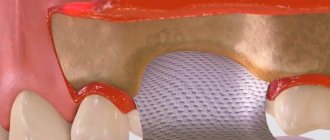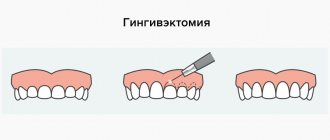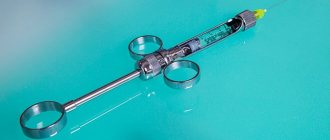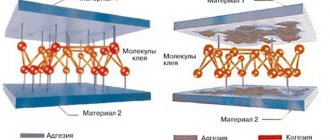Having a beautiful smile has always been a sign of health.
However, not all people can boast of beautiful teeth free of defects.
Dental restoration is a service that is very popular nowadays.
Aesthetic dentistry allows you to solve problems such as changing the shape of a tooth, its length, width, hiding chips and other imperfections, and aligning teeth in a row.
What is dental restoration
Dental restoration refers to the process of restoring the shape and functionality of damaged teeth.
If we are talking not only about tooth restoration, but also about the aesthetic component, then such terms (synonyms) as artistic restoration, cosmetic restoration or aesthetic restoration of teeth are applicable.
Dental restoration is a dental procedure aimed at both improving the appearance and bringing the teeth to a state as close as possible to the physiological state.
- The goal of restoration is to optimize the color and shape of the tooth so that the restored tooth is indistinguishable from other teeth.
- During restoration, correction and restoration of functionality and aesthetics are carried out using composite materials directly in the patient’s mouth or outside it.
- Tooth restoration differs from the installation of a filling in that tooth restoration is carried out using modern aesthetic materials that allow you to imitate enamel and dentin in the desired transparency and color range.
Let's show with an example what total work can look like.
The patient complained of abrasion, poor aesthetics, inconvenience in eating and general discomfort due to dental problems.
Another clinic installed an implant to replace a missing tooth, but there is no room for a crown because the bite height has decreased.
After a complete diagnosis, the doctor installed a deprogrammer - this made it possible to remove the usual incorrect movements of the jaw and move the lower jaw into the correct position.
Please note that there is space in the side sections.
A splint was made - a special mouthguard that the patient uses to stabilize the position of the jaw all the time, not counting meals.
In a virtual editor, the technician modeled the shape and size of the teeth - what they should be for the proper functioning of the joint and muscles of the head and neck.
When modeling, it is important to correctly “place” the meeting points of the upper and lower teeth on future crowns.
See what it looks like on a technician's computer screen. Working digitally allows the doctor and technician to discuss progress or issues that arise online. For the patient, this is expressed in the accuracy of the work and its speed.
After modeling, the technician prints a model of the jaws on a 3D printer. This model does not shrink, unlike a traditional plaster model, so the finished work is perfectly accurate - the patient spends less time in the dentist’s chair.
From the printed model, the doctor makes a silicone impression - the key to trying on a new smile. The key is filled with material and brought into the patient’s mouth, so a mock-up appears on the teeth - decorative overlays for visualizing the future smile.
Nothing happens to the teeth at this stage; the doctor begins grinding the teeth only after agreement with the patient.
The patient does not walk around with a mock-up, this is only a demonstration of the final result. In this case, we decided not to make temporary crowns and veneers, since our patient had a splint that held the jaw at the desired height. Thanks to the splint, the muscles become accustomed to the new, correct position of the lower jaw. After adaptation, the doctor made permanent restorations from Emax pressed ceramics.
Right view
and left
Finished work
And a portrait. We achieved harmonization of facial features and a beautiful, healthy smile.
Indications and contraindications
Dental restoration is carried out in the following cases:
- Correction of tooth shape, color and size.
- If the tooth has changed its position in the row.
- If the patient has crooked teeth.
- After treatment of caries, which aims to restore the aesthetics of the tooth.
- When the enamel darkens and there is pigmentation.
There are also some contraindications for restoration:
- Having an allergy to the composite material or its adhesives.
- If it is impossible to isolate the tooth and its cavity from moisture.
- Combination of pathological tooth wear and direct bite.
- Bruxism.
- Deep incisal overlap.
- Poor or lack of oral care.
Various methods and methods of dental restoration can solve the following problems:
- Correct the shape of the tooth.
- Eliminate chips and irregularities.
- Restoration of tooth enamel.
- Hide the gap between teeth.
- Align the position of the tooth in the row.
Methods of aesthetic restoration
Direct method
The restoration is carried out directly in the oral cavity; the doctor forms the crown of the tooth during the treatment process. In one visit, up to 6 units of dentition can be restored using light-curing composite materials or glass ionomer cement.
On average, it takes from 15 to 60 minutes to restore one unit. The main disadvantage is the gradual dulling of the material, the loss of the original shine that was visible after grinding. Patients who have used the direct method need to carefully select toothpaste and maintain hygiene.
Indirect method
Veneers are thin composite or porcelain plates that are placed on prepared teeth, replacing the top layer of enamel. The main feature of these onlays is that they cover the entire surface of the tooth, and not just its front side.
The procedure consists of several stages:
• preparation and implementation of treatment, cleaning of canals, filling them (if necessary);
• taking an impression to make veneers;
• installation
Veneers are indicated for patients with insufficiently straight and snow-white teeth. Thanks to the plates, the smile is perfect, but if the bite is incorrect, it is better to abandon the technique. Veneers are also contraindicated for patients who do not have chewing teeth or who engage in fairly traumatic sports (for example, boxing).
When using the indirect method, a combination of crown and onlays is possible if they are made of the same material.
Difference from filling
With the help of aesthetic restoration, the anatomical shape of the tooth, its integrity and functions are restored. On the one hand, filling is carried out for the same purpose, but there are still differences between these two methods:
• When installing a filling, the functionality of the crown is first restored, and the restoration also affects the aesthetic component, since during its implementation special materials are selected that imitate dentin and enamel, adjusting to their color and transparency.
• Installation of a filling is possible if the destruction affected no more than 1/3 of the crown. Tooth restoration can be performed in case of more pronounced damage in situations where it is not externally damaged, but requires correction of shape, color correction, or elimination of wide gaps between them.
Aesthetic dental restoration
Materials: enamel simulator with dentin
Dental clinics with modern equipment use composite compounds. They harden only under the influence of heat or light. Therefore, the material can remain elastic for a long time, allowing the dentist to create a natural relief, reproducing the natural shape. A variety of colors of enamel simulator with dentin will make your smile natural.
Composites are characterized by strength and are currently an ideal option for aesthetic restoration.
Veneers, lumineers, crowns and braces
In dental and orthodontic practice, several techniques are used aimed at restoring teeth in Orenburg, correcting the bite and eliminating aesthetic defects.
Veneers are a thin plate, the thickness of which does not exceed 0.2-0.6 mm. It is fixed to a pre-prepared surface. In dental clinics with modern equipment, minor grinding of the enamel is performed - 0.3-1 mm. The use of veneers is suitable for patients with overly large or protruding teeth.
Lumineers are thin plates-onlays, the thickness of which is 02.-0.3 mm. Their main difference is the possibility of fixation without first grinding down the enamel. They are suitable for patients with small crowns and gaps between them.
A crown is a mini-prosthesis, which is a cap that is used when filling cannot be done. With its help, you can eliminate the external defect, restore the lost function of the crown, preventing its further destruction.
A brace system is an orthodontic structure consisting of braces and an arch, with the help of which they are stretched, aligning the dentition. This type of bite correction allows you to correct the function of chewing food and improve the beauty of your smile.
Aesthetic dental restoration
Methods
Depending on the condition of the patient's teeth, the following may be used:
- Direct recovery. For direct restoration, all manipulations are performed in the patient’s mouth during one medical appointment.
Direct restoration method
To restore the crown part of a tooth, composite dental restoration is used, which involves the use of photopolymers (light-curing composite materials): composites, compomers, heliocomposites, nanocomposites.
- Composite filling materials are held in place by chemical bonds with the enamel through glue (adhesive).
- Compomers additionally release fluoride, which helps strengthen the enamel.
- Heliocomposites allow you to select the desired color and recreate natural light transmission.
- Nanocomposites are capable of imitating the optical properties of fabrics.
Dental restoration with photopolymers is carried out by a dentist-therapist and is often called artistic restoration of teeth.
Life time
No dentist can say how long such a restoration will last, since this period is individual for each patient.
- It depends on oral care, the presence or absence of bad habits, etc.
- If the diet consists of food, mainly of plant origin, then the restoration will last a long time.
- The professionalism of the dentist and compliance with all installation rules and regulations also play an important role.
The average lifespan of a light seal is five years, but can be longer.
Other methods of direct restoration:
- Installing tabs.
- In case of large losses of dental tissue, the installation of pin structures is most often used.
Based on them, a new tooth is subsequently formed.
- Before fixing the pin, the root canal is prepared.
- Then the pin is fixed into the root cavity using special cement or using modern adhesive materials.
- The most popular are anchor, titanium, fiberglass, and silver pins.
Main indications for use
• discoloration of the enamel or its darkening, which cannot be corrected by daily cleaning, professional cleansing and bleaching;
• excessive grinding of enamel and dentin, which led to a change in shape, size and disrupted the natural function of the tooth;
• appearance of defects - cracks, structural damage, chips;
• trauma, carious damage, consequences of surgical or therapeutic treatment;
• destructive tissue damage, which includes hypoplasia, fluorosis, etc.
Stages of implementation
The main stages of dental restoration are identified:
- Preparatory. At this stage, professional teeth cleaning is carried out, the color of the future tooth is determined and the shade of the composite material that will be used for restoration is selected accordingly.
- If necessary, local anesthesia is administered.
- Dental tissue affected by caries is drilled out. In case of replacing an old restoration, the old filling is drilled out and replaced with a new one.
- The tooth is isolated from saliva using a rubber dam - a latex scarf that is placed on the teeth through special holes. A restoration made from a composite without reliable isolation from saliva is not able to last long and can cause problems such as the appearance of a dark stripe or the formation of caries at the filling-tooth interface, as well as loss of the restoration.
In case of large losses of dental tissue, the installation of pin structures is most often used. Based on them, a new tooth is subsequently formed. The most popular are anchor, titanium, fiberglass, and silver pins.
- Before fixing the pin, the root canal is prepared.
- Then the pin is fixed into the root cavity using special cement or using modern adhesive materials.
- Restoration of tooth shape. To make the tooth look like a real one, a layer-by-layer restoration technique is used. Layers of composite of different shades and transparency are applied sequentially. Which will ultimately give the new tooth a natural appearance.
- Final shaping of the tooth into the required shape using burs, grinding and polishing of the filling.
Stages of restoration with veneers
- The color of the future veneer is selected.
- Local anesthesia is administered (if necessary).
- The front surface of the tooth is ground. The amount of tissue removed depends on the clinical case. Grinds down from 0.5 to 1.5 mm of hard tissue.
- Taking impressions.
- Fixation of temporary plastic plates while the permanent restoration is being manufactured. This measure is necessary to protect the ground tooth surface from infection and the negative effects of environmental factors.
- Production of a veneer onlay based on the impressions obtained in the laboratory.
- Fixing the veneer to the tooth using special glue.
Flaws
Restorations have some disadvantages:
- Composite fillings can darken and change color over time. In addition, they may lose the shine that real teeth have. If the restoration was carried out on the front teeth, then this trouble will significantly affect the aesthetics. Therefore, such restorations will have to be replaced every few years.
- Possibility of breakdown. Risk factors include pulpless teeth, as well as teeth restored completely from the root. If the chewing load on the tooth is exceeded, tooth fracture or root fracture may occur. And then the tooth will have to be removed.










